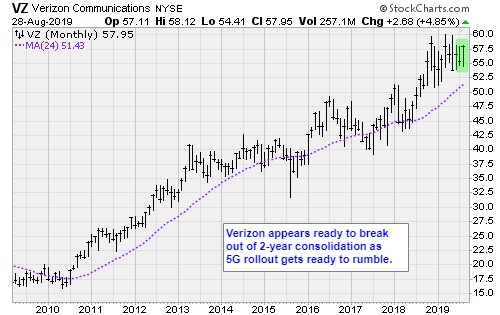Why the 5G Marketplace is Worth Fighting for … and Investing in
 |
The Samsung (SSNLF) Galaxy Note 10 has finally arrived. And it's totally understandable if you didn't notice or aren't all that excited about it.
After all, new smartphones are blasé these days. And this one would be no different. Except, it comes with the option for fifth-generation wireless connectivity.
Still blasé? Consider that not even Apple (AAPL), which is launching its iPhone 11 on Sept. 20, can boast about that yet. Cupertino doesn't plan to put 5G capability into its phones until 2020 or later.
So, Samsung gets first-mover advantage. And the device does not disappoint, according to Digital Trends editors who just took the Note 10 on a test drive in Providence, R.I.
Now, here's where it's time to start taking "Note" …
Providence is one of a handful of American cities with 5G infrastructure in place. Download speeds reached almost 2Gbps on the Verizon (VZ) Ultra Wideband 5G network.
Let that sink in for a moment.
A 2Gbps connection. That is 50x faster than most home Wi-Fi networks in the United States.
That kind of speed will change the way most of us use smartphones. We will go from checking posts on social media and watching the occasional cat video on YouTube … to consuming full-on, high-definition media like TV shows, movies and more.
And sure, it's great that we can do more cool stuff on our phones. But here's the thing. 5G wireless is set to trigger a $12 trillion cash explosion as it revolutionizes self-driving cars, factories, remote telesurgery, artificial intelligence, virtual reality and more.
As DT notes, it’s important to understand that not all 5G networks are created alike.
The Verizon and AT&T (T) networks utilize millimeter wave (mmWave) technology. This is the fastest type of 5G connection. But it’s also the flakiest.
The range is short (200 meters) and the radio waves have a tough time penetrating exterior walls. For the most part, it’s a line-of-sight thing.
Sprint (S) is building out its network on the 2.5Ghz spectrum. Connectivity is slower than mmWave, but range and penetration are much better.
And T-Mobile (TMUS) is relying on the low-band, 600 Mhz spectrum. 5G connectivity is even slower than on 2.5Ghz, but the reach is furthest.
This means T-Mobile is likely to have the quickest 5G rollout because their network will require less upfront investment in new radios and towers.
But investors should not get too wrapped in the horse race.
All wireless providers are going to get there, eventually. And they will all have parts of their 5G network strewn across all parts of the wireless spectrum.
The kicker is what becomes possible with that speed …
5G wireless solves the last-mile problem, the idea that the real cost of delivering telephone, cable and internet services to homes is the hassle of running cables and sending technicians out to connect set-top boxes and modems.
5G networks are fast, dense and have very low latency. They are also wireless. This means new business models.
Verizon and T-Mobile managers see an opportunity to meet the growing demand from so-called cord-cutters — people who are dropping expensive cable TV services in favor of video-on-demand services like Netflix (NFLX), Hulu, Amazon Prime and the upcoming Disney+.
Wireless providers will finally have the bandwidth to compete head to head with wireline telephone, internet and cable TV providers.
Digital marketing research firm eMarketer noted in July 2018 that the pace of cord-cutting is accelerating. Analysts predict cord-cutters will grow to 55.1 million by 2022, or 20.8% of the traditional cable TV market.
That’s a market worth fighting for. 5G means the wireless providers finally have the tools to tip the battle in their favor.
 |
While Verizon is a legitimate technology company, growth rates are usually slower than I like to see in the bulk of technology stocks I follow.
That aside, wireless companies are at an important inflection point. 5G changes everything, and it’s not about new smartphones from Samsung. Super-fast networks open the door wide to new industries they have been trying to break into for decades.
Verizon shares trade at 11.9x forward earnings and only 1.9x sales. Its market capitalization is a hefty $243 billion. 5G could add 30% to that total in two years as the rollout accelerates.
Keep Verizon on you radar. And keep an eye on your inbox for my next round of buy signals in the very near future, which I expect will include key 5G players.
Best wishes,
Jon D. Markman



